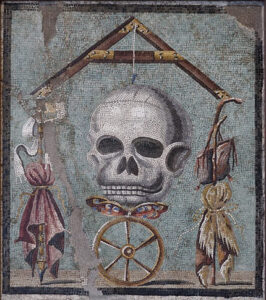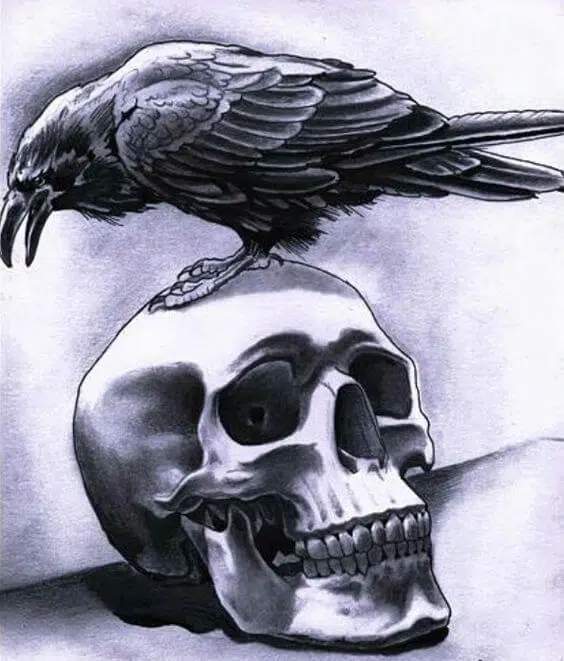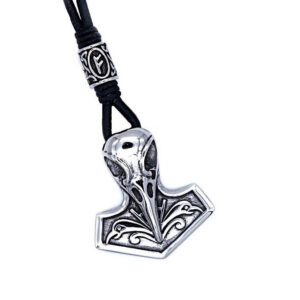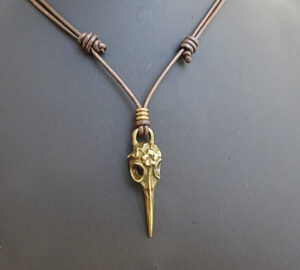Diving into the ‘Raven on a skull meaning’ takes us on a fascinating journey through the world of symbology. This hauntingly beautiful symbol, intertwined with mystery and deep cultural roots, invites us to explore the hidden realms of life, death, and transformation.
In this post, we will delve into its rich tapestry of meanings across various cultures, eras, and artistic interpretations
The Raven: A Powerful Symbol
The raven, a bird of jet-black plumage and sharp-eyed intelligence, holds a prominent place in the tapestry of world mythology and folklore. Its symbolic meanings, as diverse as the cultures that revered it, are a testament to its enigmatic nature.
In the rich narratives of Native American tribes, the raven is often seen as a trickster, using cunning and wit to challenge norms and stir transformation. It is a creature of creation myths, its cleverness often instrumental in shaping the world.
In Norse mythology, the raven takes on a more somber but equally important role. Odin, the god of wisdom, war, and poetry, had two ravens named Huginn (thought) and Muninn (memory). These ravens would fly across the world, collecting information and bringing it back to Odin, thus embodying the pursuit of knowledge and wisdom.
Celtic mythology, too, painted the raven in striking hues. The Morrigan, a war goddess, was associated with ravens and crows, linking these birds with the prophetic symbolism of war and death. In Celtic culture, the raven was also seen as a messenger from the otherworld, a bridge between life and death.
From these examples, it is clear that the raven, as a symbol, transcends mere depiction. It is imbued with profound cultural narratives and philosophies, representing everything from wisdom, prophecy, and transformation to war, death, and the supernatural. As we venture further, the raven’s place in the symbolic tableau becomes even more intriguing when juxtaposed with the skull.
Ravens: Symbolism of Wisdom, Transformation, Prophecy
As we delve further into the symbolism associated with ravens, it’s essential to consider the common themes they represent across different cultures.
Ravens are often linked with wisdom and knowledge. This connection is most visible in Norse mythology, where Odin’s ravens Huginn and Muninn symbolize thought and memory. But this association extends beyond the Norse pantheon; in many cultures, the raven’s keen observation skills and problem-solving abilities symbolize intellectual prowess and insight.
Transformation is another significant theme connected with ravens. As creatures that stimulate change and challenge norms, particularly in Native American mythology, ravens have been interpreted as symbols of transformation, signifying personal growth, change, and metamorphosis.
Ravens also bear a prophetic significance in many cultures. Their presence is often seen as an omen, sometimes foreboding doom or change. This belief traces back to various mythologies, such as Celtic traditions where the presence of a raven could signal the imminent onset of a battle.
Lastly, ravens are also associated with the supernatural. From the Morrigan in Celtic mythology to the raven spirits of Native American lore, ravens have often been seen as liaisons between the mortal world and the spiritual realm. They are considered messengers of the gods or spirits, bridging the gap between life and death.
The rich tapestry of symbolism attached to ravens makes them a potent element in the realm of symbology. Their association with wisdom, transformation, prophecy, and the supernatural adds layers of depth to their symbolic representation, particularly when juxtaposed with the skull.
Ravens: Shadows of Death, Darkness, and Mystery
Despite the profound wisdom and transformative powers attributed to ravens, these enigmatic birds often carry darker, more ominous connotations. Their stark black plumage, penetrating gaze, and solitary nature have etched a deep association with death, darkness, and mystery in the human psyche.
In several cultures, the raven’s call is seen as an omen of death. This belief ties into its role as a carrion bird, often seen hovering around battlegrounds or places of death. The sight of these creatures feasting on the remains of the deceased has earned them a fearsome reputation across many cultures.
The raven’s black plumage also connects it to darkness, both literally and symbolically. Symbolically, darkness represents the unknown, the hidden, and the subconscious. As a creature of the night, the raven thus becomes a symbol for exploring the unseen mysteries of existence.
Additionally, the raven’s inherent intelligence and cryptic behaviors have linked it to mystery. The ability of these birds to mimic human speech, their extraordinary problem-solving skills, and their complex social structures all contribute to an air of mystique surrounding them.
This dual nature of the raven, embodying wisdom and transformation on one hand, and death, darkness, and mystery on the other, sets the stage for an intriguing exploration when paired with another powerful symbol – the skull.
The Skull: A Universal Symbol of Mortality
The skull, devoid of flesh and emotion, is a stark reminder of our shared human destiny – mortality. This universal symbol carries profound significance in various fields such as art, literature, and philosophy.
Its bare-boned structure encapsulates a multitude of meanings, ranging from the grim and ominous to the transformative and enlightening.
In art and literature, the skull has often been used to symbolize death and mortality. This depiction is most commonly seen in ‘memento mori’ artworks, a Latin phrase that translates to ‘remember you must die’.
The phrase stems from a particular custom typical of ancient Rome: when a general returned to the city after a military triumph and paraded through the streets, collecting the honors bestowed upon him by the crowd, he ran the risk of being overwhelmed by pride and delusions of grandeur. To prevent this from happening, someone behind him would utter the phrase: “Respice post te. Hominem te memento” (“Look behind you. Remember that you are a man”).

Memento mori in a Roman mosaic (Archaeological Museum of Naples)
These works serve as reminders of our mortality and the transient nature of life. Similarly, in literature, skulls often appear as omens of danger or impending doom, further cementing their association with death.
However, the skull’s symbolism extends beyond these macabre connotations. In many cultures and philosophies, the skull represents transformation and rebirth. This notion stems from the idea that death is not an end but a transition to a new state of being.
The skull can also symbolize enlightenment. Stripped of flesh and external appearances, it represents the essence of humanity, devoid of superficial pretenses. In this context, the skull becomes a symbol of achieving a deep understanding of oneself and the world, untainted by external influences.
Such layered symbolism imbued in the skull makes it an intriguing symbol to explore, especially when combined with the equally enigmatic raven.
As we delve deeper into the meaning of a raven perched on a skull, these intricate narratives add depth and complexity to our understanding.
The Intersection of Symbols: Raven on a Skull Meaning
The intriguing tableau of a raven perched on a skull brings together two potent symbols, each steeped in its own rich lore, into a compelling and complex symbiosis.
This image is hauntingly beautiful, resonating with profound implications that reach deep into the core of human existence and understanding.
Firstly, let’s consider the overview of this combined symbol. The raven, a creature associated with wisdom, transformation, prophecy, and the supernatural, meets the skull, a universal emblem of mortality, rebirth, and enlightenment.
Each entity maintains its symbolic significance, yet their juxtaposition introduces a new dimension of meaning.
This isn’t just a simple amalgamation of two symbols, but rather, a creation of a dynamic narrative where meanings interact, contrast, and reinforce each other.
The analysis of these juxtaposed symbols reveals an intriguing tension. The raven, with its symbolic links to wisdom, finds an uncanny perch on the skull, an object that symbolizes death and the transience of life. This interaction conjures a fascinating paradox: the bird of wisdom resting on the symbol of mortality.
It provokes contemplation about the deep-seated human curiosity about life, death, and the wisdom that lies in understanding the relationship between the two.
Furthermore, the symbol of transformation (the raven) interlaces with the symbol of the finite nature of life (the skull). This presents an exploration of life’s cyclicality, as change, growth, and transformation are inherently tied to existence and its eventual cessation.
In other words, life’s impermanence does not diminish its potential for transformation; instead, it fuels the cycle of change and growth.
Peeling back another layer, we find the combined symbol resonates with themes of knowledge gained through loss, insight through darkness, and the cyclical nature of life and death. The raven on the skull may suggest that profound wisdom often emerges from the confrontation with our mortality.
This symbolism may allude to the human ability to find meaning, insight, and enlightenment even in the darkest and most challenging aspects of life.
Moreover, the raven perched on the skull could be a potent emblem of the cyclicality of existence. The skull, an unequivocal symbol of death, hosting the raven, a bird of wisdom and transformation, suggests the endless cycle of life and death, wisdom gained, lost, and reborn anew.
It is a visual encapsulation of the phrase ‘memento mori’ – remember you must die – yet with a transformative twist that reminds us that death is not an end, but a part of a cycle.
In conclusion, the symbol of a raven on a skull, therefore, is not just an artistic or literary image, but a powerful dialogue between two potent symbols. It is a conversation about life and death, wisdom and mortality, transformation and finiteness.
This symbol invites us to delve into the profound depths of our existence, prompting introspection, acceptance, and ultimately, a more profound understanding of our place in the cycle of life.
Raven on a Skull in Popular Culture
The symbol of a raven on a skull, rich in its philosophical and symbolic implications, has not remained confined to the pages of ancient mythologies or philosophical discourses. It has seeped into popular culture, making notable appearances in movies, books, music, and modern art forms such as tattoo artistry, graphic design, and fashion.
For instance, in the world of literature and film, the raven on a skull has often been used to symbolize foreboding, wisdom, or the cycle of life and death. In the famous works of Edgar Allan Poe, such as “The Raven,” the raven acts as a symbol of mournful and never-ending remembrance.
In film, Tim Burton’s “The Nightmare Before Christmas” uses the image of a raven on a skull as a backdrop for its gothic aesthetic, symbolizing the thin line between life and death.
In the realm of music, especially within genres like heavy metal or rock, album covers often feature this potent symbol to invoke themes of mortality, existential angst, or transformation. For instance, the band Black Label Society has used this motif on their album cover, suggesting themes of mortality and the cyclical nature of existence.
The modern adaptation of the raven on a skull symbol extends to tattoo artistry, graphic design, and fashion. In tattoo artistry, this symbol is often chosen for its deep meanings, reflecting personal beliefs or experiences related to wisdom, transformation, or an acknowledgment of mortality.
Graphic designers use this potent symbol to add depth and symbolic richness to their designs, while in the fashion industry, it’s been adopted for its striking visual appeal and profound symbolism, often seen on clothing, accessories, and jewelry.
Despite its ancient origins, the raven perched on a skull symbol has found a vibrant life in our contemporary world. It’s more than just a symbol; it’s a piece of shared human understanding, morphing with the times while still echoing the ancient wisdom of life, death, and transformation.
As we encounter this symbol in various facets of our daily lives, it continues to prompt us to reflect on these enduring human themes.
Raven On a Skull Meaning Tattoo
In the realm of tattoo artistry, a tattoo featuring a raven perched on a skull holds profound meaning and personal significance.
This design merges two powerful symbols, each with their rich and layered meanings, to create a visually striking and philosophically compelling piece of art.

The raven, known for its associations with wisdom, transformation, and the supernatural, sitting atop a skull, a symbol of mortality, rebirth, and enlightenment, creates a paradox of life and death, wisdom and mortality.
This design can represent an individual’s acknowledgment of life’s transient nature, the wisdom gained through experiences, or an appreciation of the cyclical nature of life and death. It’s a reminder of the constant dance between the ephemeral and the eternal, the physical and the metaphysical.
Moreover, due to the personal nature of tattoos, the ‘raven on a skull’ meaning can also vary greatly depending on personal experiences and beliefs, making it a unique and deeply personal emblem of one’s life journey.
Conclusion
The journey into the heart of the “raven on a skull meaning” has been a fascinating exploration. We’ve delved into the wisdom, transformation, death, and rebirth embedded in this potent symbol, threading together narratives from ancient mythologies to modern pop culture.
Symbols such as the ‘raven on a skull’ are powerful keys that unlock deeper layers of our existence. They provide a profound language, bridging the gap between life, death, and everything in between. The enduring power of these symbols lies in their ability to help us make sense of our shared human experiences and universal themes.
We invite you to remain curious and continue your exploration of symbology. Look closely at the world around you; you’ll find symbols are interwoven into the very fabric of our lives, making the mundane extraordinary and the ordinary profound.
If this deep dive into the raven on a skull meaning has resonated with you, share this post on your social media platforms. Let’s widen this conversation, inviting more people into the world of symbology. Every share or like helps spread this knowledge and stimulate richer discussions about the symbols that shape our understanding of life.
Thank you for joining us on this enriching journey into the raven on a skull meaning. As you venture ahead, keep the spirit of exploration alive, and continue unearthing the symbolism that surrounds us.
Shop Viking Jewelry
Are passionate about Vikings or Norse Myths?
Finding the ideal piece of Viking Jewelry can be challenging and time-consuming, especially if you lack inspiration or don’t know where to look.
Surflegacy, has you covered. We have a wide range of Handmade Jewelry in various styles, shapes, colors, and materials, to accentuate your Viking spirit and look. Do not hesitate to visit our selection HERE
Whatever you wear, you’ll find the ideal trendy piece to complement your wardrobe. Our jewelry is designed to be worn every day, no matter where you go or what season is. Are you ready to step up your wardrobe game?






